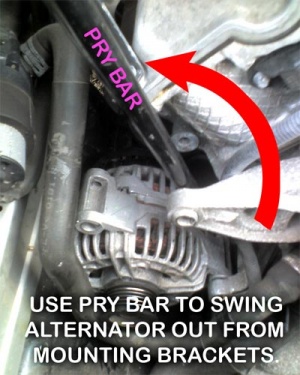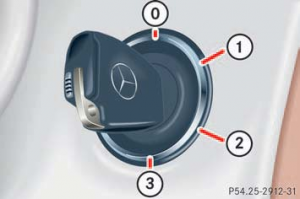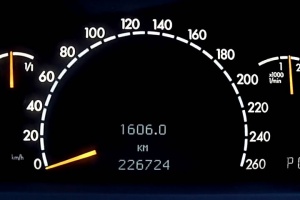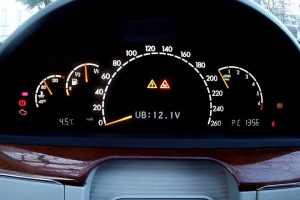Alternator: Difference between revisions
m (Pokseva moved page WIS 15.40 Generator / Alternator to Alternator) |
(reformat) |
||
| Line 1: | Line 1: | ||
Back to '''[[Index]]''' | Back to '''[[Index]]''' | ||
== | ==Specification == | ||
W220 are equipped with two types of alternators. With and without coolant cooling. | |||
W220 are equipped with two types of alternators. | |||
* S350, S430, S500: 14V/150A | * S350, S430, S500: 14V/150A | ||
* S55: 14V/180A | * S55: 14V/180A | ||
* S600: 14V/220A | * S600: 14V/220A | ||
== | |||
==Faulty Alternator== | |||
===Symptoms=== | |||
A faulty alternator will fail to charge battery and in a very extreme cases will cause a warning message "BATTERY CHARGE VISIT WORKSHOP!" to be displayed in dashboard. | |||
{| | |||
|[[File:W220_Warning_Battery_Charge_Visit_Workshop.jpg|thumb|none|Instrument cluster displaying warning message "BATTERY CHARGE VISIT WORKSHOP!".]] | |||
|} | |||
Typical symptoms are: | |||
* Charging voltage across battery terminal with engine running below about 13.8V. | |||
* Alternator output voltage greater than about 15V. A good fully charged battery should be about 14.2V across the battery terminals. | |||
* Illumination change in instrument cluster is usually an early indicator of pending alternator failure. | |||
* A sudden sound of the alternator (high frequency whine) disappearance. | |||
* Clicking sounds from the doors caused by car unlocking itself for safety purposes. | |||
===Causes=== | |||
An alternator can fail or perform poorly due to: | An alternator can fail or perform poorly due to: | ||
* Bearings worn or noisy | * Bearings worn or noisy | ||
| Line 18: | Line 33: | ||
* Rotor winding open or short circuit | * Rotor winding open or short circuit | ||
* Serpentine belt issues | * Serpentine belt issues | ||
With some electronic capability and the right tools it is easy to diagnose most alternator electrical issues. | |||
Mechanical problems are usually diagnosed by hearing unusual sounds from the alternator. | |||
== Checking Alternator Voltage == | |||
The W220 has very good in-built electronic checking systems and so you should be alerted to the usual failure mechanisms by the car itself. | |||
{| | |||
|[[File:W220_starter_switch_positions.png|thumb|none|1. Insert key into the starter switch and turn to position (1).]] | |||
|[[File:W220_Odometer_Mileage_Display.jpg|thumb|none|2. Use steering wheel buttons to navigate to screen which shows the vehicle odometer.]] | |||
|[[File:W220_Instrument_Cluster_Voltometer_Display.jpg|thumb|none|3. Press "R" button on instrument cluster three times. The voltage reading should be displayed.]] | |||
|} | |||
Start the vehicle. After few seconds the voltage display will disappear. However, you can locate it again using [[steering wheel]] buttons. The voltage reading with the vehicle running should be displayed. | |||
Correct voltage measurement on alternator should be around 14V (the voltage value must not fluctuate - see video of faulty alternator below). | |||
Sometimes the problem can be in the circuit to the [[battery]]. To test whether the [[battery]] actually receives the voltage generated by alternator, use an accurate Digital Volt Meter (DVM) and monitor the alternator output across the [[battery]] terminals. It should match voltage displayed in the instrument cluster. | |||
{| | |||
|{{#ev:youtube|https://www.youtube.com/watch?v=FNx5xwkwW3w|320|center|Voltage readings of defective alternator.|frame}} | |||
|} | |||
'''Note:''' This method is not suitable for testing the voltage of [[battery]], since several consumers activated will cause a non-objective measurement. Battery voltage must be measured without active consumers (i.e. with minimal load) and only across the battery terminals. | |||
==Replacing Alternator / Regulator== | |||
* Be sure to use the proper tools throughout the process and support your ratchet while loosening the bolts that secure the alternator. Otherwise you run a (small) risk of breaking the tab off of the timing case cover. | * Be sure to use the proper tools throughout the process and support your ratchet while loosening the bolts that secure the alternator. Otherwise you run a (small) risk of breaking the tab off of the timing case cover. | ||
* After performing this DIY the Pre-safe error comes up because the windows are not synced. When the Pre-safe activates in a crash condition, the sunroof will close, the doors will unlock, the rear door child safety locks will disengage and all the windows will close. If the windows are not normallised / reset / synced, Pre-Safe will deactivate and light up the Instrument Cluster. | * After performing this DIY the Pre-safe error comes up because the windows are not synced. When the Pre-safe activates in a crash condition, the sunroof will close, the doors will unlock, the rear door child safety locks will disengage and all the windows will close. If the windows are not normallised / reset / synced, Pre-Safe will deactivate and light up the Instrument Cluster. | ||
http://www.benzworld.org/forums/w220-s-class/1688209-alternator-voltage-regulator-replace-diy.html | http://www.benzworld.org/forums/w220-s-class/1688209-alternator-voltage-regulator-replace-diy.html | ||
[[File:W220_alternator_pry_bar_usage.jpg|thumb|none|Using pry bar to release the alternator from mounting brackets.]] | [[File:W220_alternator_pry_bar_usage.jpg|thumb|none|Using pry bar to release the alternator from mounting brackets.]] | ||
Revision as of 20:08, 28 July 2016
Back to Index
Specification
W220 are equipped with two types of alternators. With and without coolant cooling.
- S350, S430, S500: 14V/150A
- S55: 14V/180A
- S600: 14V/220A
Faulty Alternator
Symptoms
A faulty alternator will fail to charge battery and in a very extreme cases will cause a warning message "BATTERY CHARGE VISIT WORKSHOP!" to be displayed in dashboard.
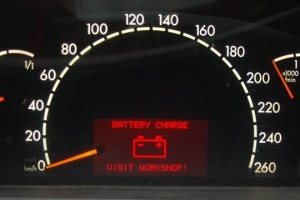 |
Typical symptoms are:
- Charging voltage across battery terminal with engine running below about 13.8V.
- Alternator output voltage greater than about 15V. A good fully charged battery should be about 14.2V across the battery terminals.
- Illumination change in instrument cluster is usually an early indicator of pending alternator failure.
- A sudden sound of the alternator (high frequency whine) disappearance.
- Clicking sounds from the doors caused by car unlocking itself for safety purposes.
Causes
An alternator can fail or perform poorly due to:
- Bearings worn or noisy
- Voltage regulator electronic component failure
- Brushes worn
- Cable fracture
- Full wave bridge diode open or short circuit
- Stator winding open or short circuit
- Rotor winding open or short circuit
- Serpentine belt issues
With some electronic capability and the right tools it is easy to diagnose most alternator electrical issues. Mechanical problems are usually diagnosed by hearing unusual sounds from the alternator.
Checking Alternator Voltage
The W220 has very good in-built electronic checking systems and so you should be alerted to the usual failure mechanisms by the car itself.
Start the vehicle. After few seconds the voltage display will disappear. However, you can locate it again using steering wheel buttons. The voltage reading with the vehicle running should be displayed.
Correct voltage measurement on alternator should be around 14V (the voltage value must not fluctuate - see video of faulty alternator below).
Sometimes the problem can be in the circuit to the battery. To test whether the battery actually receives the voltage generated by alternator, use an accurate Digital Volt Meter (DVM) and monitor the alternator output across the battery terminals. It should match voltage displayed in the instrument cluster.
Note: This method is not suitable for testing the voltage of battery, since several consumers activated will cause a non-objective measurement. Battery voltage must be measured without active consumers (i.e. with minimal load) and only across the battery terminals.
Replacing Alternator / Regulator
- Be sure to use the proper tools throughout the process and support your ratchet while loosening the bolts that secure the alternator. Otherwise you run a (small) risk of breaking the tab off of the timing case cover.
- After performing this DIY the Pre-safe error comes up because the windows are not synced. When the Pre-safe activates in a crash condition, the sunroof will close, the doors will unlock, the rear door child safety locks will disengage and all the windows will close. If the windows are not normallised / reset / synced, Pre-Safe will deactivate and light up the Instrument Cluster.
http://www.benzworld.org/forums/w220-s-class/1688209-alternator-voltage-regulator-replace-diy.html
